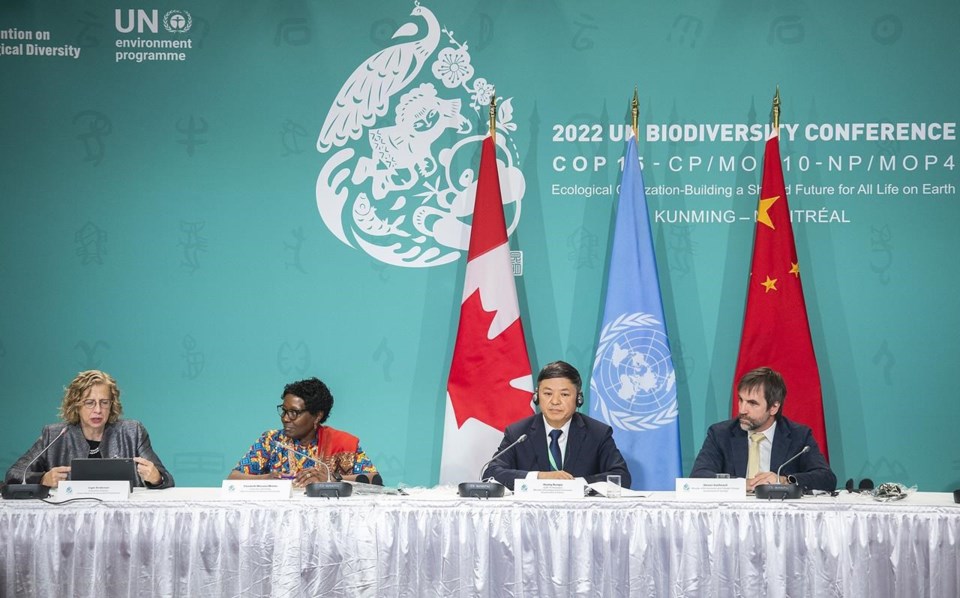MONTREAL — Hard talks on hard targets for saving the world's biodiversity began Wednesday at an international conference in Montreal, with calls for rich nations to pony up to save functioning ecosystems where most of them exist — in poor nations.
"We need developed countries to provide meaningful financial support for the countries of the global south as custodians of the world’s natural wealth following centuries of exploitation and loss," said United Nations Secretary-General Antonio Guterres as the COP15 conference began.
Delegates from more than 190 countries will try over the next two weeks to thrash out what they call a framework for preserving biodiversity with timed, measurable targets.
Prominent among them is a proposal that nearly a third of Earth's land and water should be protected by 2030. Advocates say more than 100 countries support the idea, but the draft text on conservation targets still has more brackets in it than agreed wording.
"We've made some progress," said Stephen Woodley of the International Union for Conservation of Nature, a high-profile group of governments and civil society organizations advising conference delegates. "It's tough sledding."
But funding — known in COP-speak as "mobilization of resources" — is considered just as central to success.
The rationale is simple. Most remaining biodiversity is in the developing nations of the global south, while most of the money — much of which has been generated at the expense of that biodiversity — is in the rich countries of the north.
That's where the simplicity ends.
"It is one of the tricky issues of this process," said Eddy Perez of Climate Action Network Canada.
Estimates of the possible tab vary wildly.
Perez said a group of African countries is looking for about $100 billion a year. The International Union for Conservation of Nature — an influential group of scientists and non-governmental organizations — says the figure should be twice that.
"The total need is very difficult to assess," said Florian Titze of the World Wildlife Fund. "The only thing they have in common is it's in the hundreds of billions."
Negotiators haven't even agreed on how the tab should be tallied.
There's money for biodiversity from governments, spent both internationally and domestically. There's money from private finance that does the same.
And there's funding from public and private sources that works against it. The UN says in 2019 major investment banks provided an estimated $2.6 trillion to sectors that governments and scientists agree are driving ecosystem destruction.
On Tuesday, Canada announced it would earmark an additional $350 million for biodiversity projects in developing countries. On Wednesday, the European Union sounded skeptical about upping its contribution from its pledge of $7 billion by 2025.
Hugo-Maria Schally, the European Commission’s Directorate General for the Environment, told the conference that the current amounts being discussed are "not realistic."
Dollar amounts aren't even the whole story.
"It is capacity building," said Perez. "It is technology transfer.
"It can't just be a number issue."
As well, mobilization of resources must be accompanied by disclosure standards, so both investors and voters can assess how their money is being used.
"That is one of the important elements of reform of the financial system," Titze said. "We don't even have the data that tells us, for example, how a financial institution is contributing to the destruction of nature."
Both he and Perez agree that talks on the financial side of preserving biodiversity aren't as advanced as those on conservation areas.
The conservation side has a defined target. Finance has a 10-point plan signed on to by a scant 16 countries.
But one can't move forward without the other, said Titze.
"If we're not setting the right ambition for the (conservation) measures that need to be taken, it's almost impossible to set the level of ambition in finance. One side of the room is waiting for the other."
Titze said one thing is certain.
"Now is the time to make progress."
This report by The Canadian Press was first published Dec. 7, 2020.
— By Bob Weber in Edmonton and Jacob Serebrin in Montreal
The Canadian Press




